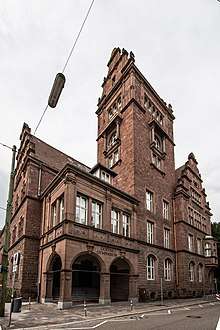Goethe Gymnasium Karlsruhe
The Goethe Gymnasium is a German High School in Karlsruhe, a town in Southern Germany. It specialises in the natural sciences and modern languages and is named after Johann Wolfgang von Goethe. The school offers a bilingual English profile, which makes it unique in Karlsruhe.
| Goethe-Gymnasium Karlsruhe | |
|---|---|
 | |
| Address | |
Renckstraße 2, 76133 Germany | |
| Information | |
| Type | Gymnasium |
| Principal | Albrecht Aichelin |
| Faculty | 80 |
| Enrollment | 862 |
Profile and school life today
English and French or Latin are taught from fifth grade at the Goethe Gymnasium. From seventh grade they offer a bilingual English profile. In eighth grade students have the option to choose between a language profile, with Italian as their third foreign language, or a natural science profile in which science and technology are compulsory.
The bilingual orientation of the school entails intensive English lessons in fifth and sixth grade. In twelfth grade students have the option to take the Cambridge Certificate of Advanced English.
The Goethe Gymnasium has their own Big Band and multiple choirs that perform inside and outside of school. A German drama group completes the cultural extracurricular activities of the school.
History
Foundation (1908-1918)
The Goethe School was founded in 1908. Dr. Peter Treutlein was the first headmaster. Classes started with 417 students and 16 full-time teachers in the magnificent building that was built for 1 million German marks (now approximately US$500,000).
During World War I the school was used as a barracks while classes were moved elsewhere.
Time between the wars and World War II (1919 - 1945)
The time between 1919 and 1933 was shaped by headmaster Dr. Karl Ott. In this period the school's reputation as a prestigious school that successfully combined the natural sciences and modern languages was established.
After Hitler seized power in 1933 Dr. Ott was de facto replaced by convinced Nazi Dr. Oeß and actually dismissed in 1934. Like other schools the Goethe-School could not avoid Gleichschaltung - Nazi terminology for the process of establishing a totalitarian system of control over society.
In World War II the school was once again used as accommodation for various organizations. The school was severely damaged by a series of airstrikes, especially on 26/27 September and 4 December 1944.
New beginning and stabilisation (1945-1965)
In the early years classes were taught in several buildings, sometimes even in the teachers' private homes. The rebuilding of the school started in 1947 and was formally reopened three years later in 1950. The Goethe Gymnasium still offers two profiles in continuation of the old tradition: a profile focused on modern languages with Latin as the first foreign language, and a profile focused on maths and the natural sciences with special emphasis on maths.
In these years the school established a particularly good reputation through its contacts with the US, France, Italy and Finland.
Professor Dolland (1945-1951) and Mr. Eisele (until 1966) were headmasters of the school at the time.
Years of change (1966-1995)
In the course of the babyboom years and a general lack of schools, teachers and funding (the so-called Bildungsnotstand), the school gained more and more students. However, the economic recession and multiple political and societal disruptions forced the school to reconsider things that were previously taken for granted. Not even the Goethe Gymnasium was spared from the repercussions of these events. After a period of conflict the school managed to resume a state of constructive collaboration with parents and students in 1973, granting them more say in school matters.
At the same time the school was evolving in other areas: French was offered as a first foreign language from 1971. In the same year, coeducation was introduced, thereby ending the 45-year period as a school for boys.
In 1977 the school started implementing the tracking system, where students are divided into separate classes according to their choice of courses, instead of continuing to educate them in the same class in all subjects, for their last two years of education.
Like many other schools in Karlsruhe, the Goethe Gymnasium experienced a decrease in the number of students during the 1980s. However, their cooperation with the nearby Fichte Gymnasium allowed them to maintain a broad choice of courses.
Mr. Steinbacher (until 1976) and Mr. Mangler (until 1993) were headmasters during these years.
A new profile (from 1995)
In the 1990s the school was further put to the test. Europeanization and globalization, as well as an ever-changing student body and new career expectations presented new challenges. The school reacted to these changes by creating a new profile that met the new requirements: in addition to the language profile, which offers Italian as a third foreign language, a natural science profile was introduced, which makes courses dedicated to scientific work compulsory. The students immediately accepted these new profiles.
Centennial
The school celebrated its centennial in 2008. In anticipation of this event the history club was founded in 2006. A book to commemorate the event was compiled from private and official archives and an exhibition was organized. The festivities culminated in a ceremony and celebration on February 23.
Alumni
Every year on the first Friday in February at 8pm the school organizes a reunion for all alumni.